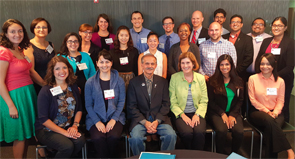Our workforce supply is predicted to be inadequate for demand in 2020 and 2025. The study predicts a waning supply of rheumatologists (by clinical FTE), exacerbated by rising numbers of patients with rheumatic diseases, retiring baby boomers and more women and millennials in the workforce, who have an anticipated lower productivity due to other priorities that compete for their time.
The COTW is addressing the Workforce Study results in a multiphase plan, including working with the Rheumatology Research Foundation and ARHP to increase rheumatology fellowship funding and accelerate specialized NP/PA rheumatology training for rheumatology health professionals. I want to especially thank Daniel Battafarano, DO, and Seetha Monrad, MD, along with Kamilah Lewis (ACR staff), who invested many hours of effort to ensure the Workforce Study was all encompassing with sound methodology and principles. The COTW has also been involved in the expansion of the global training and workforce as further described below.
Global Outreach
The ACR continues to recognize its leadership role in rheumatology internationally. I have enjoyed being the ACR ambassador to our international colleagues this year. Having visited many national and international meetings this year, I can assure you the ACR/ARHP Annual Meeting remains the premier scientific educational meeting in the world, bringing together scientists, clinicians and ideas to Advance Rheumatology! I want to thank Richard Loeser, MD, and all the AMPC for their tireless efforts this year in organizing this meeting, as well as Lucy Killgore, Ron Olejko, Stacey Chandler and Donna Hoyne (ACR staff), who make the ACR/ARHP Annual Meeting the great international congress that it is. Soon, our new Learning Management System will be the central hub for ACR online education and will disseminate new scientific discovery to rheumatologists worldwide.
But science is more than an annual meeting or online education; the ACR has been the medium for facilitating international scientific collaboration as well. The ACR/EULAR (European League Against Rheumatism) Exchange has been successful in bringing junior scientists together to facilitate scientific exchange and initiating international relationships among investigators. This year, the ACR launched exchange programs with PANLAR (Pan American League of Associations for Rheumatology) and IRA (Indian Rheumatology Association) to bring recently minted rheumatologists to the U.S. to spend a month at a host institution and attend the ACR/ARHP Annual Meeting. These collaborations benefit our domestic members by enriching rheumatology science in the U.S. and facilitating export of our educational resources.
I want to thank Sharad Lakhanpal, MD, Kris Lohr, MD, and Anne Bass, MD, for helping making this exchange program a reality. I hope it continues to be strengthened and expanded in the future.
Communications & Marketing

ACR FIT members who attended Advocacy 101, with ACR/ARHP President Joan Von Feldt (seated, green jacket) and President-Elect Sharad Lakhanpal (seated, with bent fork pin on his jacket).


